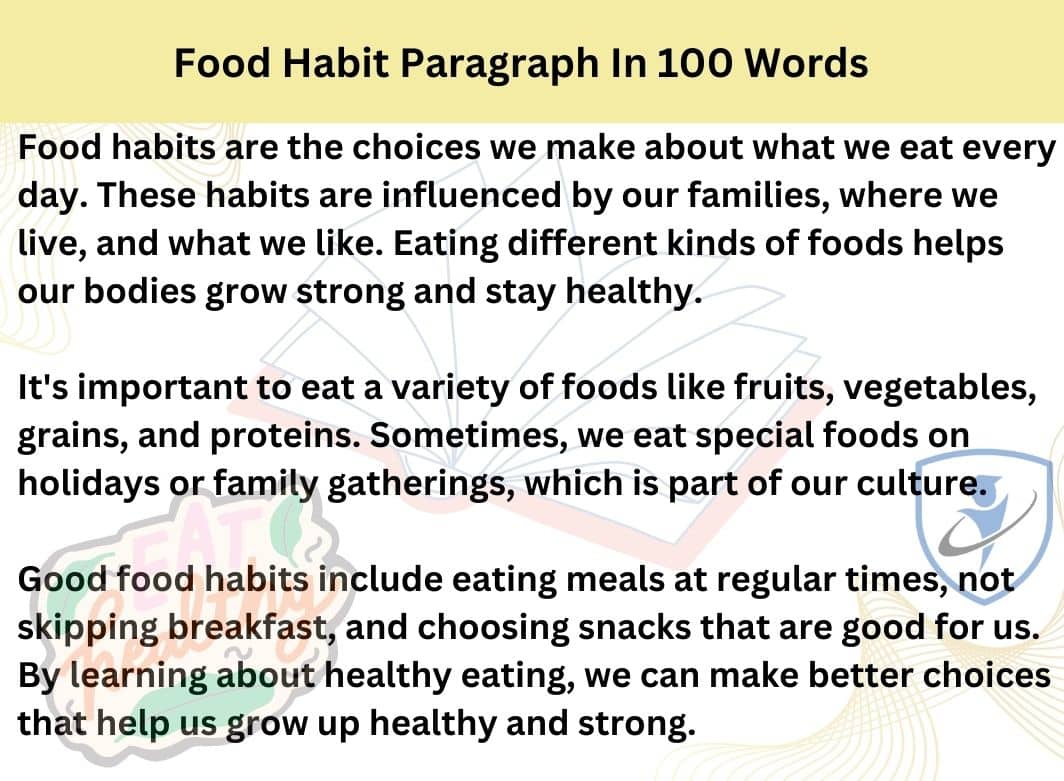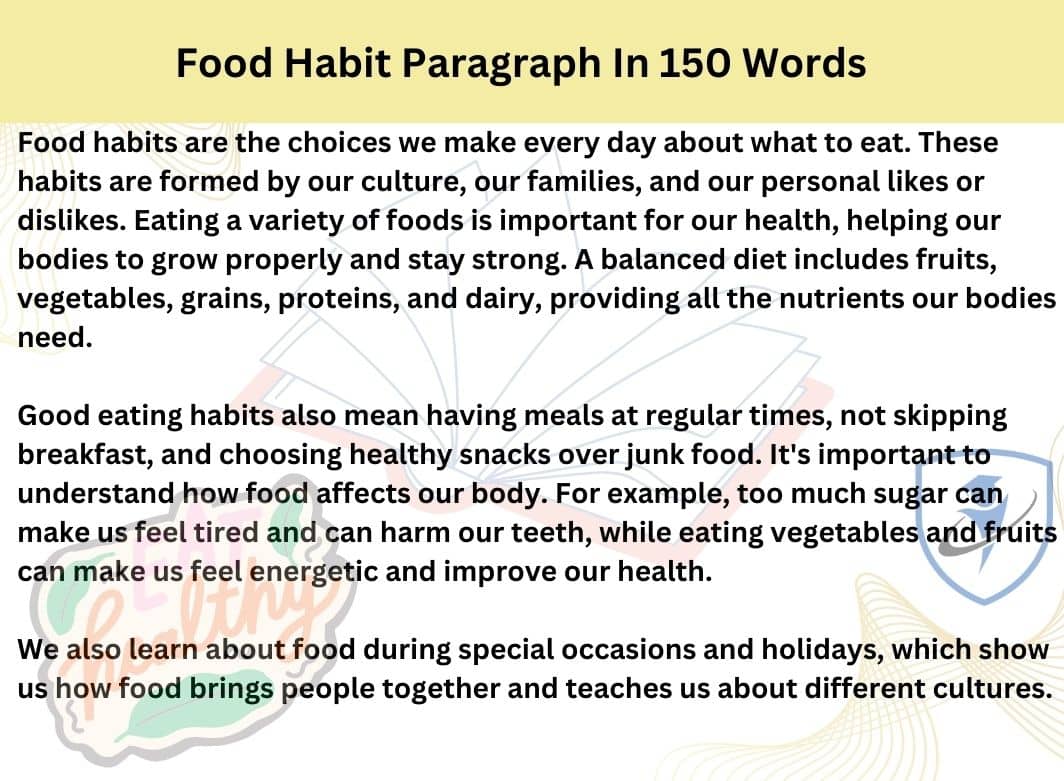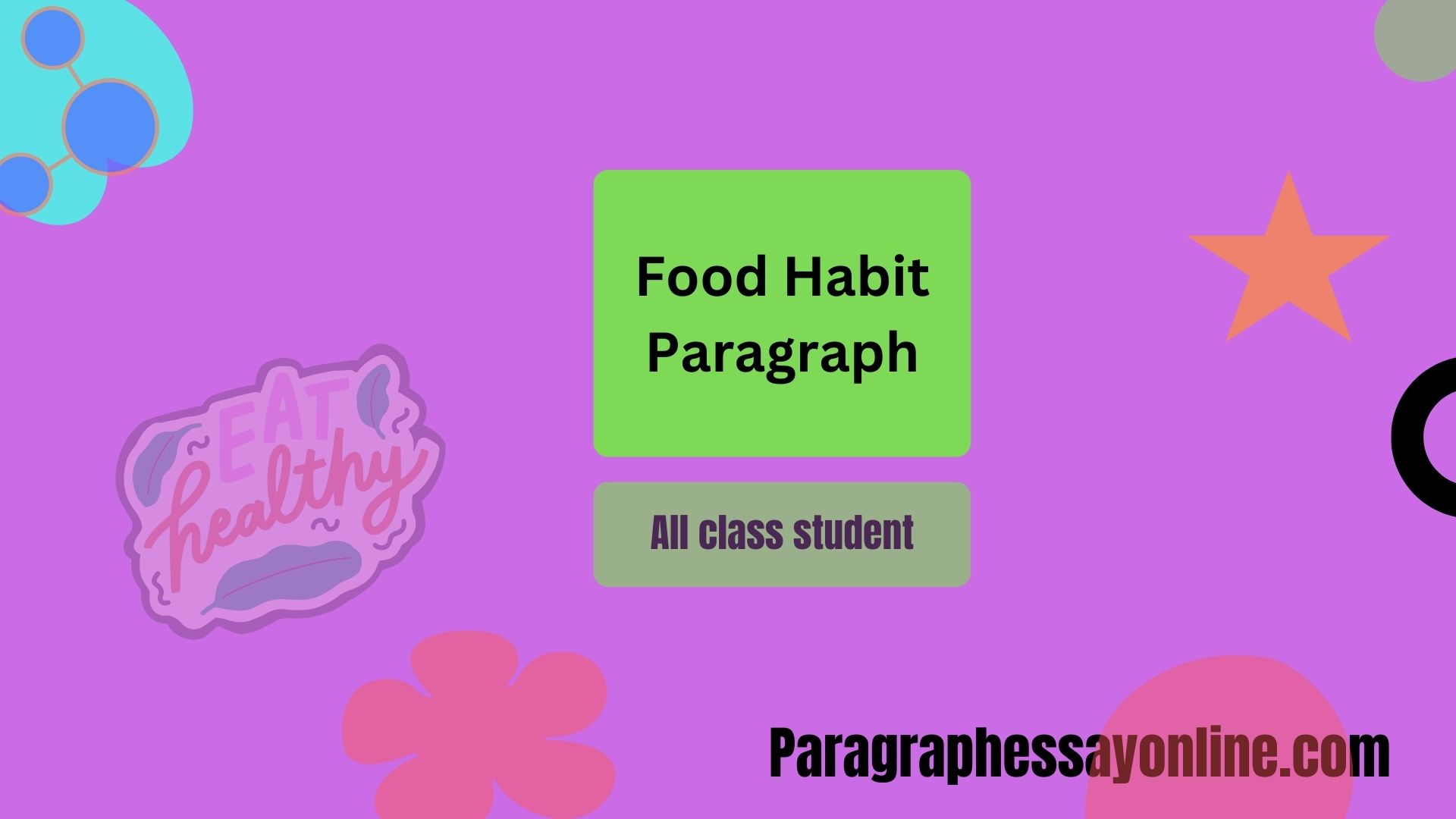Food Habit Paragraph
Food Habit Paragraph For All Class (100- 500 words)
Food habits are the patterns and preferences that dictate what, when, and how we eat. They’re shaped by culture, family, and personal choices, impacting our health and lifestyle. Understanding and modifying these habits can lead to better nutrition and overall well-being. It’s about balancing tradition with personal health goals to create a sustainable and enjoyable way of eating.
Food Habit Paragraph 100 Words For 1, 2, 3 Students
Food habits are the choices we make about what we eat every day. These habits are influenced by our families, where we live, and what we like. Eating different kinds of foods helps our bodies grow strong and stay healthy.
It’s important to eat a variety of foods like fruits, vegetables, grains, and proteins. Sometimes, we eat special foods on holidays or family gatherings, which is part of our culture.
Good food habits include eating meals at regular times, not skipping breakfast, and choosing snacks that are good for us. By learning about healthy eating, we can make better choices that help us grow up healthy and strong.

Paragraph On Food Habit 150 Words For 4 & 5 Students
Food habits are the choices we make every day about what to eat. These habits are formed by our culture, our families, and our personal likes or dislikes. Eating a variety of foods is important for our health, helping our bodies to grow properly and stay strong. A balanced diet includes fruits, vegetables, grains, proteins, and dairy, providing all the nutrients our bodies need.
Good eating habits also mean having meals at regular times, not skipping breakfast, and choosing healthy snacks over junk food. It’s important to understand how food affects our body. For example, too much sugar can make us feel tired and can harm our teeth, while eating vegetables and fruits can make us feel energetic and improve our health.
We also learn about food during special occasions and holidays, which show us how food brings people together and teaches us about different cultures.

Food Habit Paragraph 200 Words For 6, 7, 8 Students
Food habits are an essential part of our lives, shaping how we eat, what we eat, and why we eat certain foods. These habits are influenced by various factors including culture, family traditions, and personal preferences.
A balanced diet is crucial for maintaining good health, and it should include a variety of nutrients from different food groups such as fruits, vegetables, grains, proteins, and dairy. Eating a wide range of foods ensures that our bodies receive the necessary vitamins and minerals needed for growth, energy, and repair.
Developing healthy food habits at a young age can have a lasting impact on our lifestyle and well-being. This includes eating regular meals, especially a healthy breakfast to start the day, and choosing snacks wisely. Drinking plenty of water and limiting sugary drinks are also important habits. Understanding the value of portion control and listening to our body’s hunger and fullness signals can prevent overeating.
Food also plays a significant role in social and cultural events, teaching us about the diversity of culinary traditions around the world. Learning to appreciate and try new foods can expand our tastes and enrich our dining experiences. Adopting healthy food habits doesn’t mean we have to give up all our favorite treats.
Paragraph On Food Habit 250 Words For 8,9,10 Students
Food habits, the routines and preferences surrounding what we eat, are pivotal to our health and cultural identity. They’re influenced by a myriad of factors, including family practices, societal trends, and personal choices.
As we grow, understanding the impact of our food choices on our health becomes increasingly important. A balanced diet, rich in nutrients, supports physical growth, mental development, and overall well-being. It should encompass a variety of food groups: fruits, vegetables, grains, proteins, and dairy, ensuring a comprehensive intake of essential nutrients.
Healthy eating habits also extend to meal patterns—eating at regular intervals, starting the day with a nutritious breakfast, and selecting healthier snack options. Staying hydrated, minimizing sugary and processed foods, and understanding portion sizes contribute to maintaining a healthy weight and preventing chronic diseases.
Moreover, food habits are deeply entwined with cultural heritage and social interactions. Sharing meals during festivals or family gatherings not only nourishes the body but also strengthens bonds and fosters a sense of belonging. Experimenting with different cuisines can broaden our palates and cultural understanding.
However, establishing healthy food habits also involves critical thinking about the marketing and availability of food. It’s important to recognize how advertisements, peer pressure, and convenience can influence our food choices.
Making conscious, informed decisions about what we eat empowers us to take control of our health and encourages a more sustainable relationship with food. It lays the foundation for a healthy lifestyle, enabling us to thrive physically, mentally, and socially.
Food Habit Paragraph 300 Words For 9, 10, 11, 12 Students
Food habits encompass the complex interplay of dietary choices, cultural traditions, and personal preferences that dictate our eating patterns.
These habits are crucial not only for physical health and growth but also for mental well-being and social integration. As we navigate through adolescence into adulthood, understanding and refining our food habits can significantly impact our overall quality of life.
A balanced diet, incorporating a variety of nutrients from fruits, vegetables, whole grains, protein sources, and dairy, is fundamental to supporting bodily functions, cognitive development, and emotional stability. Healthy eating habits include regular meal times, starting with a nutritious breakfast, opting for healthy snacks, and practicing portion control.
These habits help in maintaining an optimal weight, enhancing academic and athletic performance, and preventing chronic diseases later in life.
Developing a critical perspective towards food marketing and making conscious choices about what we consume are vital skills in today’s consumer-driven society.
Appreciating and engaging with the social aspects of food can enrich our understanding of the world and strengthen community ties.
However, the journey to establishing healthy food habits also involves navigating challenges such as fast food culture, peer pressure, and the prevalence of misinformation about diet and health. Educating ourselves about nutritional science, seeking reliable sources of information, and learning to listen to our bodies’ needs are key steps towards making empowered food choices.
As we grow, these habits can guide us towards a fulfilling and healthy lifestyle, marked by a deep appreciation for the role of food in our lives.
Food Habit Paragraph 500 Words
Exploring the intricate world of food habits reveals a rich tapestry of choices that influence our health, identity, and social interactions. Beyond mere sustenance, the food we consume plays a pivotal role in shaping our lifestyle, offering a window into cultural heritage and personal values. As students transition from adolescence to young adulthood, the development of informed and sustainable food habits becomes crucial, impacting long-term well-being and environmental stewardship.
The cornerstone of healthy eating lies in diversity and balance, embracing a wide array of nutrients that fuel our bodies and minds. A focus on whole foods, such as fruits, vegetables, lean proteins, whole grains, and healthy fats, provides the essential building blocks for growth, learning, and physical activity.
Yet, the modern diet often leans heavily towards convenience, leading to an overreliance on processed foods rich in sugars, unhealthy fats, and artificial additives. This shift has implications not only for individual health, with rising rates of obesity and non-communicable diseases, but also for the environment, as industrial food production strains natural resources and contributes to climate change.
Food literacy, or the understanding of food’s impact on health, environment, and economy, emerges as a key component of navigating these challenges. It involves recognizing the value of food labels, understanding the basics of nutrition, and appreciating the environmental footprint of our dietary choices. Armed with this knowledge, individuals can make conscious decisions that support sustainable agriculture and minimize waste, contributing to a healthier planet.
Moreover, food habits are deeply interwoven with social dynamics. Meals serve as a medium for connection, bringing people together to share experiences and traditions. In this context, food becomes a language of its own, capable of bridging cultural divides and fostering a sense of community. This social aspect of food encourages exploration and open-mindedness, enriching our palate and understanding of the world.
Yet, amidst these opportunities for connection and exploration, challenges persist. The digital age has introduced a bombardment of mixed messages about diet and health, creating confusion and often leading to unhealthy eating patterns. Navigating this landscape requires critical thinking and a cautious approach to trends and fads in nutrition, emphasizing the importance of evidence-based guidelines and personalized advice from health professionals.
In response to these complexities, the movement towards mindfulness in eating has gained traction. Mindful eating encourages a deep engagement with the sensory experiences of food, promoting a better understanding of hunger cues and satisfaction signals. This approach fosters a healthier relationship with food, emphasizing enjoyment and gratitude over restriction and guilt.
As students embark on this journey of discovery and self-improvement, the role of education becomes paramount. Schools and communities can play a transformative role by offering programs that teach cooking skills, provide nutritional education, and encourage physical activity. Such initiatives empower young individuals to take charge of their health and cultivate habits that align with their values and aspirations.
This journey, marked by curiosity, compassion, and critical thinking, paves the way for a lifetime of well-being and conscious citizenship.
More Paragraphs:
| City Life Vs Village Life Paragraph. |
| A Postman Paragraph. |
| My English Teacher Paragraph. |
| Truthfulness Paragraph. |
| My Ambition In Life Paragraph. |
Frequently Asked Questions For Paragraph On Food Habit
Q: Why are healthy food habits important?
Answer: Healthy food habits are vital for maintaining good health, supporting physical growth, enhancing mental function, and preventing chronic diseases such as obesity, heart disease, and diabetes. They also contribute to overall well-being and quality of life.
Q: How can I develop healthy food habits?
Answer: Developing healthy food habits involves making informed choices about what you eat, prioritizing whole foods over processed ones, ensuring a balanced intake of nutrients, and listening to your body’s hunger and fullness cues. It also includes regular meal patterns and mindful eating practices.
Q: Can food habits affect the environment?
Answer: Yes, food habits can significantly impact the environment. Choices that favor plant-based foods and locally sourced produce over processed and imported foods can reduce carbon footprint, water usage, and environmental degradation.
Q: How do cultural practices influence food habits?
Answer: Cultural practices shape food habits through traditional diets, cooking methods, and mealtime customs. They influence the types of food consumed, how food is prepared, and the social context in which meals are shared.
Q: What is mindful eating?
Answer: Mindful eating is the practice of paying full attention to the experience of eating and drinking, both inside and outside the body. It involves noticing the colors, smells, textures, and flavors of food, as well as the thoughts and feelings that arise during mealtime.
